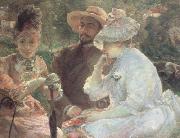 |
Marie Bracquemond -- Click Here
|
|
French Impressionist Painter, 1840-1916
.was a French Impressionist artist described by Gustave Geffroy in 1894 as one of the "le trois grandes dames" of Impressionism alongside Berthe Morisot and Mary Cassatt.However, her often omission from books on women artists indicate the success of her husband, F??lix Bracquemond, in his campaign to thwart her development as an artist. |
|
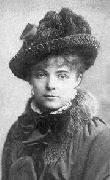 |
Marie Bashkirtseff -- Click Here
|
|
(Russian: November 11, 1858 October 31, 1884) was a Ukrainian-born Russian diarist, painter and sculptor.
Marie BashkirtseffBorn Maria Konstantinovna Bashkirtseva in Gavrontsy near Poltava, to a wealthy noble family, she grew up abroad, traveling with her mother across most of Europe. Educated privately, she studied painting in France at the Acad??mie Julian, one of the few establishments that accepted female students. The Acad??mie attracted young women from all over Europe and the United States. One fellow student was Louise Breslau who Marie viewed as her only rival. Marie would go on to produce a remarkable body of work in her short lifetime, the most famous being the portrait of Paris slum children titled The Meeting and In the Studio, (shown here) a portrait of her fellow artists at work. Unfortunately, a large number of Bashkirtseff's works were destroyed by the Nazis during World War II.
From the age of 13, she began keeping a journal, and it is for this she is most famous. Her personal account of the struggles of women artists is documented in her published journals, which are a revealing story of the bourgeoisie. Titled, I Am the Most Interesting Book of All, her popular diary is still in print today. The diary was cited by an American contemporary, Mary MacLane, whose own shockingly confessional diary drew inspiration from Bashkirtseff's. Her letters, consisting of her correspondence with the writer Guy de Maupassant, were published in 1891.
The grave of Marie BashkirtseffDying of tuberculosis at the age of 25, Bashkirtseff lived just long enough to become an intellectual powerhouse in Paris in the 1880s. A feminist, in 1881, using the nom de plume "Pauline Orrel," she wrote several articles for Hubertine Auclert's feminist newspaper, La Citoyenne. One of her famous quotes is: Let us love dogs, let us love only dogs! Men and cats are unworthy creatures. |
|
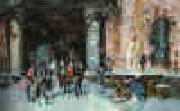 |
Mariano Fortuny y Marsal -- Click Here
|
|
1838-1874
Spanish
Mariano Fortuny y Marsal Gallery
He was born in Reus, a town near Taragona in the autonomous community of Catalonia in Spain. His father died when he was an infant, his mother by age 12, thus Mariano was raised by his grandfather, a cabinet-maker. His grandfather taught him to make wax figurines. At the age of 9, at a public competition in his town a local patron, Domingo Soberno, encouraged further study. At the age of 14 years he moved to Barcelona with his grandfather. A sculptor, Domingo Taleru, secured him a pension of to allow him to attend the Academy of Barcelona. There he studied for four years under Claudio Lorenzale, and in March of 1857 he gained a scholarship that entitled him to two years of studies in Rome starting in 1858. There he studied drawing and grand manner styles.
In 1859, he was called by the Spanish government to depict the campaigns of the Spanish-Moroccan War. The expedition lasted for only about six months, and he returned to Spain in the summer of 1860.
The battle of Tetuan by Mariano Fortuny (1863-73)Since the days of Velazquez, there had been a tradition in Spain of memorializing battles and victories in paint; and on the basis of his experiences, Fortuny was commissioned by the city of Barcelona to paint a large canvas diorama of the capture of the camps of Muley-el-Abbas and Muley-el-Hamed by the Spanish army. He began his composition of The battle of Tetuan on a canvas fifteen metres long; but though it worked on and off on it during the next decade, he never finished it.
The greater influence of this travel on Fortuny was his subsequent fascination with the exotic themes of the world of Morocco, painting both individuals and imagined court scenes. He visited Paris in 1868 and shortly afterwards married Cecilia de Madrazo, the daughter of Federico Madrazo, who would become curator of the Prado Museum in Madrid. Together, they had a son, Mariano Fortuny y Madrazo, who became a well-known fashion and tapestry designer. Another visit to Paris in 1870 was followed by a two years' stay at Granada, but then he returned to Rome, where he died somewhat suddenly on the 21st of November 1874 from an attack of tertian ague, or malaria , contracted while painting in the open air at Naples and Portici in the summer of 1874.
Fortuny paintings are colorful, with a vivacious iridescent brushstroke, that at times recalls the softness of Rococo painting but also anticipates impressionist brushwork, Fortuny??s recollection of Morocco is not a costume ball, but a fierce, realistic portrait which includes bare-chested warriors. Richard Muther states:
??his marvellously sensitive eye ?? discerned the stalls of Moorish carpet-sellers, with little figures swarming, and the rich display of woven stuffs of the East; the weary attitude of old Arabs sitting in the sun; the sombre, brooding faces of strange snake-charmers and magicians. This is no Parisian East??every one here speaks Arabic??.
Fortuny often painted scenes where contemporary life had still not shaken off the epaulets and decorations of ancient traditions such a the ????Burial of a matador???? and couples signing marriage contracts (La Vicaria). Each has the dazzle of bric-a-brac [1]ornament, but as in his painting of the ????Judgement of the model????, that painterly decorative air of Rococo and Romanticism was fading into academicism and left to confront the naked reality of the represented object. He inherited Goya??s eye for the paradox of ceremony and reality. |
|
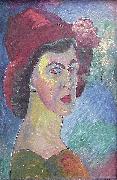 |
Marianne von Werefkin -- Click Here
|
|
Marianne von Werefkin (Russian, 10 September 1860, Tula, Russia - 6 February 1938, Ascona, Switzerland), born Marianna Wladimirowna Werewkina (transliteration Marianna Vladimirovna Verevkina), was a Russian-Swiss Expressionist painter.
Marianne von Werefkin was born the daughter of the commander of the Ekaterinaburg Regiment. In 1880, she became a student of Ilya Repin, the most important painter of Russian Realism. Her progress was dealt a setback by a hunting accident in 1888 in which she shot her right hand, the one with which she painted.
In 1892 she met Alexej von Jawlensky, who desired to be her protege, and in 1896 she, Jawlensky, and their servant moved to Munich. For the sake of Jawlensky's painting, Werefkin interrupted her painting for almost ten years.
She created her first expressionist works in 1907. In these she followed Paul Gauguin's and Louis Anquetin's style of "surface painting", while also showing the influence of Edvard Munch. In 1909, the Neue Kenstlervereinigung Menchen (New Association of Artists in Munich, NKVM) was founded. It became a forum of exhibitions and programming.
At the outbreak of the First World War, they immigrated to Switzerland, near Geneva. They later moved to Zurich. By 1918, they had separated, and Werefkin moved alone to Ascona, on Lago Maggiore. In 1924 she founded the artist group "Grober Bar" (i.e., Big Bear, Ursa Major). |
|
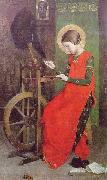 |
Marianne Stokes -- Click Here
|
|
(1855 Graz, Styria - August 1927 London), born Marianne Preindlsberger in the Austrian province of Styria, was an Austrian painter. She settled in England after her marriage to Adrian Scott Stokes (1854-1935), the landscape painter, whom she had met in Pont-Aven. Marianne Stokes was considered one of the leading artists in Victorian England.
Preindlsberger first studied in Munich under Lindenschmidt and having been awarded a scholarship for her first picture, 'Muttergluck', she worked in France under Pascal Adolphe Jean Dagnan-Bouveret (1852-1929), Colin and Gustave Courtois (1853-1923). She painted in the countryside and Paris, and, as with many other young painters, fell under the spell of the rustic naturalist Jules Bastien-Lepage. Her style continued to show his influence even when her subject matter changed from rustic to medieval romantic and biblical. While in France she met the Finnish painter Helene Schjerfbeck, in whose company she visited Pont-Aven in 1883.
Her first salon painting, 'Reflection', which had been painted in Brittany, was exhibited in 1885 at the Royal Academy. Her work was also shown at the Grosvenor Gallery, New Gallery, and the Society of British Artists and in 1885, a year after her marriage, she took to using the name 'Mrs. Adrian Stokes'. She held a joint exhibition with her husband at the Fine Art Society in 1900. The Stokes' lived in St Ives where Marianne was a member of the Newlyn School. Having no children, they regularly travelled abroad, frequently to the Tyrol, and in 1905 to Slovakia and the High Tatra. Here they spent about half a year sketching and painting in the villages of Važec, Mengusovce and Ždiar. Adrian Stokes concentrated on landscapes with images of hay-harvesting and picturesque cottages, while Marianne Stokes painted portraits showing fine detail of the garments. These paintings provide a valuable record of the Slovak culture.
After abandoning oils, and inspired by the Pre-Raphaelite movement, she painted flat compositions in tempera and gesso, her paintings giving the impression of being frescoes on plaster surfaces. She was an Associate of the Royal Society of Painters in Water Colours.
|
|
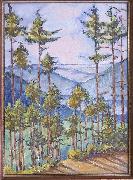 |
Marianne North -- Click Here
|
|
(24 October 1830 - 30 August 1890), English naturalist and flower-painter, was born at Hastings, the eldest daughter of a Norfolk landowner, descended from Roger North. |
|
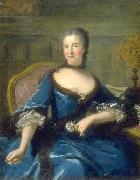 |
Marianne Loir -- Click Here
|
|
French Painter, ca.1715-1769 |
|
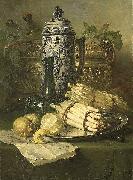 |
Maria Vos -- Click Here
|
|
painted Stilleven met kan van steengoed in 1878 |
|
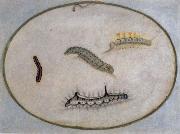 |
Maria Sibylla Merian -- Click Here
|
|
German Baroque Era Illustrator, 1647-1717,Daughter of Mattheus Merian. After her father's death, her mother married in 1651 the flower still-life painter Jacob Marell, who became Maria Sibylla's teacher. On 16 May 1665 she married Johann Andreas Graff, another pupil of her stepfather. She thenceforth specialized in illustrations of flowers, fruit and, especially, grubs, flies, gnats and spiders. In 1670 the family moved to Nuremberg. In 1675 Sandrart referred to her in the Teutsche Academie, reporting that she painted on cloth (i.e. silk, satin). With Graff, she produced a book of flowers, the first part appearing in 1675; a second edition, enlarged by parts 2 and 3 ,came out in 1680, entitled Florum fasciculi tres. It included 36 engravings intended to serve as patterns for embroidery. |
|
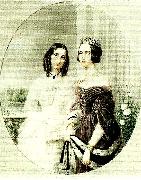 |
maria rohl -- Click Here
|
|
Maria Christina Röhl, född i Stockholm den 26 juli 1801, död i Klara församling, Stockholm den 5 juli 1875, var en svensk porträttmålare som avbildade ett flertal samtida kända personer. Medlem i konstakademien (1843) och hovleverantör. Hennes tavlor hänger bland annat på Nationalmuseum i Stockholm. En samling av 1800 porträtt finns på Kungliga Biblioteket.
Maria Röhl växte upp i en rik familj, men då hon blev föräldralös 1822 drabbades hon av fattigdom. Hon tänkte först bli guvernant, men professorn och kopparstickaren Christian Forsell undervisade henne då i teckning; hon hade redan tidigare undervisats av målaren Alexander Hambr??, och fick nu lära sig att utföra snabba och realistiska porträtt i blyerts; hon arbetade i blyerts och krita i svartvitt.
Hon bodde hos familjen Forsell, där hon först avbildade familjens vänner och sedan, då det hade blivit modernt att låta avbilda sig av "mamsell Röhl", försörjde hon sig på detta i trettio år. Hon utnämndes till kunglig hovmålare 1843, studerade 1843-1846 under Leon Cogniet vid Franska konstakademien i Paris och hade sedan en atelj?? i Brunkebergs hotell i Stockholm. Fotografikonsten blev en svår konkurrent under hennes sista år. Även systern Eva Röhl (1810-96) uppges ha haft viss konstärlig begåvning. |
|
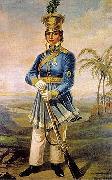 |
Maria Quiteria -- Click Here
|
|
(1792-1853) was a Brazilian Lieutenant and national heroine. She served in the Brazilian war of independence in 1822-23 dressed as a man. She was promoted to cadet and Lieutenant and decorated with the Imperial order. She has been called "Brazilian Joan of Arc". |
|
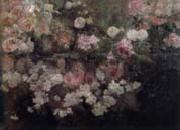 |
Maria Oakey Dewing -- Click Here
|
|
American Painter, 1845-1927 |
|
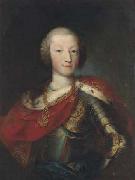 |
Maria Giovanna Clementi -- Click Here
|
|
Italy (1690 -1761 ) , Painter
|
|
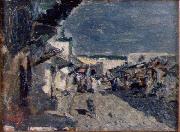 |
Maria Fortuny i Marsal -- Click Here
|
|
painted Marocco, mercato e case in 1869 |
|
 |
Maria Chmielowska -- Click Here
|
|
painted Nu debout in about 1895
|
|
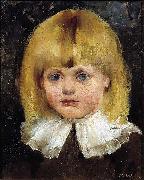 |
Maria Catharina Wiik -- Click Here
|
|
(b Helsinki, 2 Aug 1853; d Helsinki, 19 June 1928). Finnish painter. She studied in Paris at the Academie Julian from 1875 to 1876 under Tony Robert-Fleury and continued her studies with him in the same studio between 1877 and 1880. Her paintings appeared at the Salon for the first time in 1880 (e.g. Marietta, 1880; Helsinki, priv. col., see Katerma, p. 31). The realist techniques Wiik absorbed in Paris came to form the basis of her work, tranquil in composition and restrained in colour. Her favourite subjects were relatively small-scale portraits such as Hilda Wiik (1881; Helsinki, Athenaeum A. Mus.) and still-lifes (e.g. Still-life, c. 1880; Helsinki, Athenaeum A. Mus.). Like many other foreign painters Wiik went to Brittany to paint. In 1883-4 she worked in Concarneau and Pont-Aven, where her enthusiasm for plein-air painting brought immediacy to her work and greater brightness to her colours (e.g. Breton Farm, 1883; Naantali, Fereningen Hedvigsminne). She preferred to record her impressions in portraits, although she also painted small, light-filled landscapes. In 1889 Wiik worked under the direction of Puvis de Chavannes in Henri Bouvet's studio in Paris, and in the same year she visited St Ives where she painted, among others, two major works: Out in the World (Helsinki, Athenaeum A. Mus.) and the St Ives Girl (Helsinki, priv. col., see Katerma, p. 93). Both works show Wiik moving towards an ever more internalized and minimal mode of expression, thereby taking part in the process that led, in the 1890s, to a general abandonment of realism in favour of a greater emphasis on emotion. Out in the World, which shows an old woman's sad parting from a young girl who is leaving home to begin work, shows a change in technique with the use of more united colour surfaces and of tone painting. (This work was awarded a bronze medal at the Exposition Universelle in Paris in 1900.) During the 1890s and the early 20th century Wiik's travels were concentrated in Scandinavia, although she visited Paris in 1905. |
|
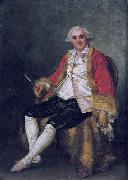 |
Marguerite Gerard -- Click Here
|
|
Marguerite Gerard (28 January 1761 in Grasse - 18 May 1837 in Paris) was a French painter and etcher. She was the daughter of Marie Gilette and perfumer Claude Gerard. At 8 years-old she became the sister-in-law of Jean-Honore Fragonard, and when she was 14 she became his pupil, and she often worked with him. She was also the aunt of the artist Alexandre-Évariste Fragonard. |
|
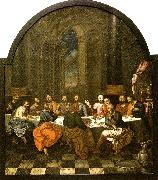 |
margareta capsia gavelin -- Click Here
|
|
Margareta Capsia, född 1682 i Sverige, död 20 juni 1759 i Åbo, var en svensk-finländsk konstnär, den första kvinnliga konstnären i Finland och en av de första i Skandinavien. Hon var kyrkomålare och målade altartavlor, men utförde även personporträtt.
Capsias föräldrar Gottfried Capsia och Anna Schultz hade kommit till Sverige från Holland. Hon gifte sig i Stockholm 1719 med prästen Jacob Gavelin och flyttade till Vasa 1721, där hon gjorde sig känd som altarmålare i Österbotten. 1730 flyttade paret till Åbo, där hon blev känd i hela landet som konstnär. Hon målade altatavlorna i en rad kyrkor, bla målade hon 1739 Säkylä kyrkas altartavla, och i den gamla kyrkan i Paltamo, den så kallade bildkyrkan, finns bland annat en altartavla från 1727 som föreställer nattvarden. Hennes altartavlor beskrivs som individualistiska och naivt ärliga bibelillustrationer, och hon ansågs som landets då främsta altarkonstnärer tillsammans med Mikael Toppelius.
Hon var en av de få kvinnliga konstnärerna kända i Skandinavien före 1800-talet, tillsammans med Ulrika Pasch i Sverige och Johanne Marie Fosie i Danmark. I Finland var även Helena Arnell känd under samma tid. |
|
|
|
|
|
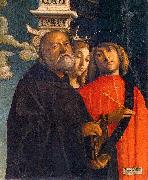 |
Marescalco, Il -- Click Here
|
|
Italian, approx. 1470-1538 |
|
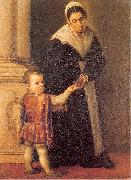 |
Marescalca, Pietro -- Click Here
|
|
Italian Painter, ca.1520-1589 |
|
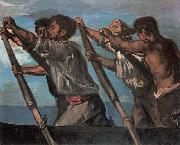 |
Marees, Hans von -- Click Here
|
|
German Painter, 1837-1887
was a German painter. He mainly painted country scenes in a realistic style. Von Mar??es was born in Elberfeld, Germany. At age 16, he was sent to the Berlin Academy. In 1857, he moved to Munich. In 1869, he visited France, the Netherlands and Spain. He served in the Franco-Prussian War (1870?C71) and then lived in Berlin and Dresden for a while. In 1873, he decorated the library walls of the newly built Naples Zoological Institute in Italy. |
|
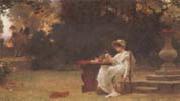 |
Marcus Stone -- Click Here
|
|
British
1840-1921
English painter, son of Frank Stone, ARA, was trained by his father and began to exhibit at the Academy before he was eighteen; and a few years later he illustrated with much success books by Charles Dickens, Anthony Trollope, and other writers, friends of his family. He was elected an associate of the Royal Academy in 1877, and academician in 1887. In his earlier pictures he dealt much with historical incidents, but in his later work he occupied himself chiefly with a particular type of dainty sentiment, treated with much charm, refinement and executive skill. |
|
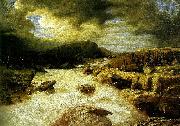 |
marcus larson -- Click Here
|
|
Simon Marcus Larson, född 5 januari 1825, Lilla Örsätter, Åtvidaberg, död 25 januari 1864 i London, var en svensk målare. Han tillhörde Dusseldorfskolan och skildrade naturens krafter på ett romantiskt och dramatiskt sätt. Larson hade en kort karriär och avled vid 39 års ålder, men ses ändå som en av Sveriges främsta 1800-talskonstnärer.
1856 var Larson i Dusseldorf och på julafton skissade han på ett solnedgångsmotiv vid den bohuslänska kusten, men Larson drömde om att måla en större tavla, hans atelje var alltför trång. Så en dag när han satt i stans populäraste caf?? och drack öl fick han id??n att han skulle måla i caf??lokalen. Sagt och gjort så hyrde han lokalen i 14 dagar. Duken han spände upp var 10-12 fot hög och 18 fot bred.
Efter 10 dagar var tavlan klar. Tavlan ställdes ut på akademien och det byggdes en utsiktsramp för att åskådarna skulle få en överblick över tavlan, priset var 5 Silbergroschen per titt och det annonserades att intäkterna skulle gå till välgörande ändamål, vilket fick stort uppseende, särskilt bland övriga konstnärer, utställningen varade mellan 25 jan. och 15 feb. 1857 Tavlan ställdes också ut bland annat i Köln och Berlin sedan till Salon Carre i Paris där den hyllades. Därefter ställdes den också ut i Stockholm där Larson tänkte skänka tavlan till staten tillsammans med köpet av Vattenfall i Småland, men då Larson på hösten inte fick sälja nämnda tavla tog han ned den stora tavlan och tog den med sig när han lämnade Sverige och fortsatte sina resor, han visade den under några år, sista gången någon skrivit om tavlan var 1863, Efter Larsons död i London försvann tavlan. |
|
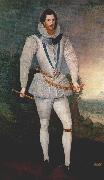 |
Marcus Gheeraertz the Younger -- Click Here
|
|
painted Robert Devereaux, Earl of Essex in 1596 |
|
|
|
 |
Marco Ricci -- Click Here
|
|
(5 June 1676 - 1730) was an Italian painter of the Baroque period. He was the nephew of Sebastiano Ricci. After receiving his first instruction in art from his uncle, he visited Rome, where he was for some years occupied in drawing vedute.
Ricci was born at Belluno. In 1710 he came to England with his uncle, and his vedute of ruins and architecture (capricci) found many patrons. Marco Ricci etched several plates from his own designs, consisting of views and landscapes, with ruins and figures, including a set of twenty-three prints, entitled Varia Marci Ricci Pictoris priestantissimi experimenta ab ipsomet auctore inventa, delineata atque incisa, et a me Carolo Orsolini Veneto incisore in unum collecta, c. Anno 1730, Venetiis. He died in Venice.
|
|
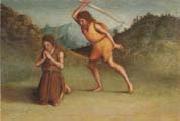 |
Marco Palmezzano -- Click Here
|
|
Italian Painter and Architect , ca.1460-1539 |
|
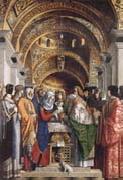 |
Marco Marziale -- Click Here
|
|
Italian Painter, active ca.1492-1507,Italian painter. He was first recorded in 1492 as one of several assistants to Giovanni Bellini in the Doge's Palace in Venice; in an inscription on his earliest known work, a damaged Virgin and Child with Saints and a Donor (1495; Zadar, St Mary, Treasury), he called himself a pupil of Gentile Bellini. Visual confirmation of his close association with both Bellini brothers is provided by the rather large number of his signed and dated works, many of which are closely based on compositional motifs by Giovanni, but which in their linearity and angularity more closely resemble the style of Gentile. The influence of German art, and of Derer in particular, has often been noted in the sharply focused and densely packed details, the harsh modelling and the expressive ugliness found in much of Marziale's work. |
|
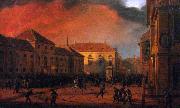 |
Marcin Zaleski -- Click Here
|
|
was a Polish painter.
Zaleski was born in Krakew. Among his works was a series of paintings on the November Uprising in Warsaw, to which he was an eyewitness as well as numerous other paintings of the city. His work is featured in Turkey's Adam Mickiewicz Museum and the Gomel Palace, among other locations. He died in Warsaw.
|
|
|
|
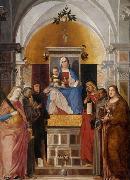 |
Marcello Fogolino -- Click Here
|
|
(active 1510-1548) was an Italian painter of the Renaissance or Mannerist style. Originally from the Friuli, he worked early in his life in Vicenza. Returning to Friuli in 1520-21, he came to reflect the painterly style of Il Pordenone. He completed a painting of Saints Francis and John the Baptist with Prophet Daniel for the Duomo in Pordenone. He was banished from Venice, for complicity in a murder in 1527, and went to Trento. He worked painting frescoes in the Tridentine region, including Castel Buonconsiglio, Castello Malpaga, Villa Salvotti, and Palazzo Sardagna.
|
|
 |
Marcello Bacciarelli -- Click Here
|
|
16 February 1731 - 5 January 1818) was an Italian painter of the late-baroque and Neoclassic periods.
He studied in Rome under Marco Benefial. In 1750 he was called to Dresden, Saxony, where he was employed by Elected King Augustus III of Poland; after whose death he went to Vienna, and thence to Warsaw. There he met and worked by the side of Italian painter in Dresden, Vienna and Warszawa , Bernardo Bellotto. He was the Director there of the new set up Academy of Arts of Warsaw.He painted a set of the Polish kings, from Boleslaus Chrobry downwards. That of Stanislaus II, Stanisław August Poniatowski has been engraved by A. de Marcenay de Ghuy, Kestner, and A. Fogg. Bacciarelli also painted scenes from the History of Poland. He died at Warsaw.
A number of his paintings were painted for King Stanisław August Poniatowski of Poland and are in the Royal Castle in Warsaw. |
|
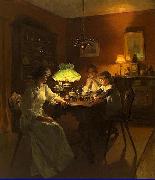 |
Marcel Rieder -- Click Here
|
|
France (1852 -1925 ) - Painter
|
|
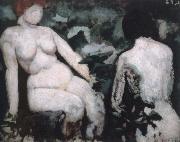 |
marcel duchamp -- Click Here
|
|
marche duchamp (1887 to 1968),French painter, sculptor and writer. The art and ideas of Duchamp, perhaps more than those of any other 20th-century artist, have served to exemplify the range of possibilities inherent in a more conceptual approach to the art-making process. Not only is his work of historical importance
|
|
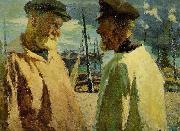 |
Marcel Couchaux -- Click Here
|
|
painted Pecheurs dans le port de Honfleur in 1920 |
|
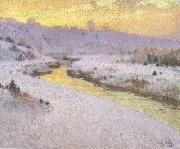 |
marc-aurele de foy suzor-cote -- Click Here
|
|
Canadian Painter, 1869-1937
was a Canadian painter and sculptor. He was born in Arthabaska, Quebec in 1869. He studied at the École des Beaux-Arts in Paris with L??on Bonnat during the 1890s. After his return to Quebec in 1908, he produced many impressionist paintings of the Quebec landscape, as well as portraits, nudes, historical paintings and later sculptures. |
|
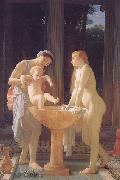 |
Marc Charles Gabriel Gleyre -- Click Here
|
|
Charles Gleyre (full name Marc Gabriel Charles Gleyre) (Chevilly, Vaud canton, 2 May 1806 - 5 May 1874), was a Swiss artist. He took over the studio of Paul Delaroche in 1843 and taught a number of younger artists who became prominent, including Claude Monet, Pierre Auguste Renoir, Alfred Sisley and James Abbott McNeill Whistler.
Self portraitHis father and mother died when he was eight or nine years of age; and he was brought up by an uncle in Lyon, France, who sent him to the industrial school of that city.
Going to Paris in his late teens, he spent four years in intense artistic study. The following four years Gleyre spent in meditative inactivity in Italy, where he became acquainted with Horace Vernet and Louis Leopold Robert; and six years more were spent wandering in Greece, Egypt, Nubia and Syria. At Cairo he was attacked with ophthalmia, or inflammation of the eye, and in Lebanon he was struck down by fever. He returned to Lyons in shattered health.
On his recovery he proceeded to Paris, and, establishing a modest studio in the rue de Universite, began carefully to work out the ideas which had been slowly shaping themselves in his mind. Mention is made of two decorative panels Diana leaving the Bath, and a Young Nubian as almost the first fruits of his genius; but these did not attract public attention until much later, and the painting by which he practically opened his artistic career was the Apocalyptic Vision of St John, sent to the Salon of 1840.
This was followed in 1843 by Evening, which at the time received a medal of the second class, and afterwards became widely popular under the title Lost Illusions. It depicts a poet seated on the bank of a river, with his head drooping and a wearied posture, letting his lyre slip from a careless hand, and gazing sadly at a bright company of maidens whose song is slowly dying from his ear as their boat is borne slowly from his sight.
|
|
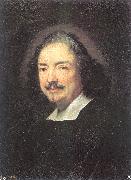 |
Maratta, Carlo -- Click Here
|
|
Italian Baroque Era Painter, 1625-1713
was an Italian painter of the High Baroque period, active mostly in Rome. Born in Camerano, then part of the Papal States. He came as a boy of 12 to apprentice in the studio of Andrea Sacchi. Like Sacchi, his paintings have a classicizing tone, inspired by the works of the great painters from Parma and Bologna: Carracci, Guercino, and Lanfranco. He developed a close relationship with Sacchi till the death of his master in 1661. He worked alongside Francesco Cozza, and Domenico Maria Canuti in the decoration of the Palazzo Altieri. His first prominent work is an Adoration of the Shepherds for San Giuseppe die Falegnami in 1650. He came to establish one of the most prominent art studios in Rome of his time. Other major works are the The Mystery of the Trinity Revealed to St. Augustine (c. 1655) painted for the church of Santa Maria dei Sette Dolori, The Appearance of the Virgin to St. Philip Neri (c. 1675) now in the Pitti Palace of Florence, The Virgin with Saints Carlo Borromeo and Ignatius of Loyola and Angels (c. 1685) for the church of Santa Maria in Vallicella, and The Assumption of the Virgin with Doctors of the Church (1689) for Santa Maria del Popolo, . His numerous depictions of the Virgin earned him the nickname Carluccio delle Madonne (Little Carlo of the Madonnas). The style of Maratta is a classicized Baroque, more restrained and composed than the styles of Cortona and Carracci, thus more allied to the traditions of Sacchi, Albani, and Reni. He was one of the artists favored by Giovanni Bellori. Maratta was known for his insightful portraiture. In 1650, Maratta was introduced to pope Alexander VII, who commissioned many paintings including one of his greatest works, a painting of Constantine destroying the idols for the Baptistry of the Lateran. This work brought Maratta increased fame in the Vatican, and in 1704 Maratta was knighted by pope Clement XI. Other works include an altarpiece in the San Francesco Saverio Chapel of the Church of the Gesu, in the right transept. In 1679 or 1680, a daughter, Faustina Maratti Zappi was born to Maratta by a mistress, |
|
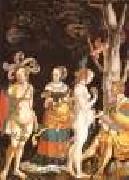 |
MANUEL, Niklaus -- Click Here
|
|
Swiss Northern Renaissance Painter, ca.1484-1530
was a Swiss dramaturg, painter, graphic artist and politician. |
|
|
|
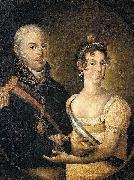 |
Manuel Dias de Oliveira -- Click Here
|
|
(1764 - 1837) |
|
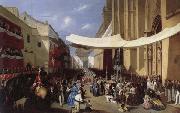 |
Manuel Cabral Y Aguado Bejarano -- Click Here
|
|
Spanish , 1827-1891
|
|
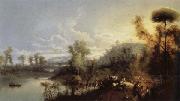 |
Manuel Barron Y Carrillo -- Click Here
|
|
Spanish , 1814-1884
|
|
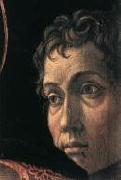 |
MANTEGNA, Andrea -- Click Here
|
|
Italian Early Renaissance Painter, ca.1431-1506
Italian painter and printmaker. He occupies a pre-eminent position among Italian artists of the 15th century. The profound enthusiasm for the civilization of ancient Rome that infuses his entire oeuvre was unprecedented in a painter. In addition to its antiquarian content, his art is characterized by brilliant compositional solutions, the bold and innovative use of perspective and foreshortening and a precise and deliberate manner of execution, an aspect that was commented upon during his lifetime. He was held in great esteem by his contemporaries for his learning and skill and, significantly, he is the only artist of the period to have left a small corpus of self-portraits: two in the Ovetari Chapel; his presumed self-portrait in the Presentation in the Temple (Berlin, Gemeldegal.); one in the Camera Picta (Mantua, Pal. Ducale) and the funerary bust in his burial chapel in S Andrea, Mantua, designed and probably executed by himself. His printmaking activity is technically advanced and of great importance, although certain aspects of the execution remain to be clarified. |
|
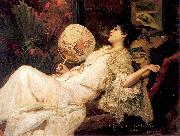 |
Manovens, Francisco Masriera -- Click Here
|
|
Spanish Painter, 1842-1902 |
|
|
|
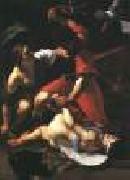 |
MANFREDI, Bartolomeo -- Click Here
|
|
Italian Baroque Era Painter, 1582-1622
Italian painter. In the 17th century he was known throughout Italy and beyond as Caravaggio's closest follower and his works were highly prized and widely collected. More than simply aping Caravaggio's style, Manfredi reinterpreted his subjects and rendered new ones, drawing upon Caravaggio's naturalism and dramatic use of chiaroscuro. His paintings were often praised by his contemporaries as equal to Caravaggio's and he was subsequently emulated and imitated by other Roman Caravaggisti during the 1610s and 1620s. Yet by the 18th century his works were forgotten or confused with those of Caravaggio himself, |
|
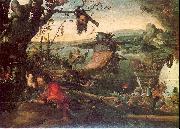 |
Mandyn, Jan -- Click Here
|
|
Dutch Northern Renaissance Painter, ca.1500-1560 |
|
 |
MANDER, Karel van -- Click Here
|
|
b. 1548, Meulebeke, d. 1606, Amsterdam
Dutch painter, poet, and writer. Born of a noble family, after much wandering he settled in Haarlem in 1583 and founded a successful academy of painting with Hendrik Goltzius and Cornelis Cornelisz (1562 C 1638). He is best known for The Book of Painters (1604), which contains about 175 biographies of Dutch, Flemish, and German painters of the 15th C 16th centuries; it became for the northern countries what Giorgio Vasari's Lives of the Painters had been for Italy. |
|
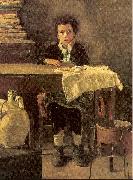 |
Mancini, Antonio -- Click Here
|
|
Italian Academic Painter, 1852-1930
Italian painter. He entered the Istituto di Belle Arti, Naples, at the age of 12; while still an adolescent he produced accomplished works such as Head of a Young Girl (1867; Naples, Capodimonte). On his graduation in 1873, Mancini, together with Francesco Paolo Michetti and Vincenzo Gemito, was at the forefront of VERISMO in Neapolitan art. Sharing a studio with Gemito, he painted the street boys, musicians and dancers of Naples, creating an anti-academic, popular art. His patron, Albert, Count Cahen of Antwerp (1846-1903), encouraged him to visit Paris in 1875, where he met Manet and Degas. After a second visit in 1877 |
|
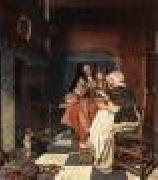 |
MAN, Cornelis de -- Click Here
|
|
Dutch Baroque Era Painter and Printmaker, 1621-1706 |
|
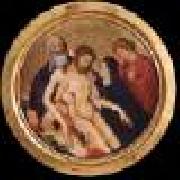 |
MALOUEL, Jean -- Click Here
|
|
Netherlandish Gothic Era Painter, ca.1365-1415
North Netherlandish painter, active in Burgundy. He was the son of the heraldic artist Willem Maelwael and uncle of the Limbourg brothers. First recorded as a painter in 1382, he is then documented on 20 September 1396 for a commission to provide designs for textiles with decorative armorial bearings for Queen Isabeau of Bavaria, wife of Charles VI, for which he received payment on 27 March 1397. By 5 August 1397 he was in Dijon, where he succeeded Jean de Beaumetz as court painter and Valet de Chambre to Philip the Bold, Duke of Burgundy. Malouel was highly paid, and his annual pension was considerably more than that of Beaumetz or of the sculptor Claus Sluter. One of the first works Malouel produced for the Duke was a painting of the Apostles with St Anthony (untraced), paid for on 11 November 1398, which the Duke is known to have kept in his private oratory. On 18 March 1398 wooden supports were purchased for Malouel to paint five large altarpieces for the Charterhouse of Champmol, outside Dijon. The subject-matter of the paintings is not specified in the document, although the dimensions of the panels are given. The Martyrdom of St Denis (Paris, Louvre; for illustration see BELLECHOSE, HENRI) has been identified as one of these five panels, on the basis of its possible provenance and its dimensions, which correspond approximately to those given in the document. In May 1416, however, Henri Bellechose received pigments to 'perfect' a painting of the Life of St Denis, and this document, in conjunction with the earlier one, has been interpreted to suggest that Bellechose completed a work left unfinished by Malouel. |
|
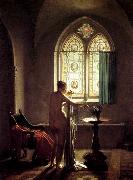 |
MALLET, Jean-Baptiste -- Click Here
|
|
French Painter, 1759-1835,French painter. A pupil of Simon Julien in Toulon, he was then taught by Pierre-Paul Prud'hon in Paris. He exhibited at every Salon between 1793 and 1827, obtaining a second class medal in 1812 and a first class medal in 1817. He executed very few portraits (Chenier, Carcassonne, Mus. B.-A., is an exception), preferring to paint nymphs bathing and graceful classical nudes such as the Graces Playing with Cupid (Arras, Abbaye St Vaast, Mus. B.-A.). He established his reputation with gouache genre scenes of fashionable and often libertine subjects, always elegant and refined, in the style of Louis-Philibert Debucourt and Louis-Leopold Boilly, and remarkable for the delicacy and brilliance of their brushwork: for example At the Laundry Maid's and the Painful Letter (both Paris, Mus. Cognacq-Jay). They reveal a knowledge of 17th-century Dutch painting in the treatment of details (transparent crystal, reflections on silk or satin) as well as the choice of themes: Military Gallant (Paris, Mus. Cognacq-Jay). Mallet's meticulously precise paintings are one of the best records of fashionable French furnishings and interiors at the end of the 18th century and the beginning of the 19th. |
|
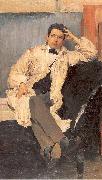 |
Maliavin, Philip -- Click Here
|
|
Russian Painter, 1869-1940 |
|
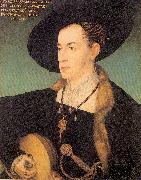 |
Maler, Hans -- Click Here
|
|
Austrian, Active 1500-29
|
|
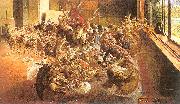 |
Malczewski, Jacek -- Click Here
|
|
Polish Painter, 1858-1929 |
|
 |
Malbone, Edward Greene -- Click Here
|
|
American Miniaturist, 1777-1807
.American miniature painter. Like his boyhood friend Washington Allston, he was encouraged in his artistic pursuits by Samuel King, who lent him engravings to study. In autumn 1794 Malbone set himself up as a miniature painter in Providence, RI, where he worked for two years, achieving almost immediate success. His earliest miniatures, such as that supposedly of Nicholas Brown (1794; New York, NY Hist. Soc.), although somewhat primitive, demonstrate his precosity. The sitters' faces are modelled with a stippling technique and chiselled planes; their outlines are distinct and crisp. These first compositions all include a conventional portrait background, usually a red curtain pulled back to reveal a blue sky. Despite the laboured technique, they are lively, direct and sensitive. During the second half of the 1790s Malbone travelled the eastern USA in search of commissions. He renewed his friendship with Allston in Boston and later visited New York and Philadelphia. In 1801 he was in Charleston, SC, where he befriended the miniature painter Charles Fraser, on whose work he had a strong influence. He developed a brilliant technique of delicate, barely perceptible crosshatching, using interwoven lines of pale colours to create graceful forms. |
|
 |
Maksymilian Gierymski -- Click Here
|
|
Gierymski (Warsaw 1846 - Reichenhall, Bavaria 1874) was a Polish painter, specializing mainly in watercolours. He was the older brother of painter Aleksander Gierymski.
As a seventeen-years-old boy, he participated in the January Uprising. He was educated at the Warsaw Drawing School initially, but then received a government scholarship in 1867 and went to study at the Academy of Fine Arts in Munich. He became one of the leading painters of the Munich realistic school. Initially best known for this battle paintings, he also created many landscape paintings, especially of southern Poland, which he visited several times.
Successful western Europe completely, he did not gain approval nor popularity in Poland of the 19th century, although he sent paintings to exhibitions in Warsaw regularly from 1968 on. He did however win awards at exhibitions in Munich (1869) and in Berlin (1872).
|
|
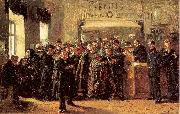 |
Makovsky, Vladimir -- Click Here
|
|
Russian, 1846-1920
Painter, brother of Konstantin Makovsky. He studied at the Moscow School of Painting, Sculpture and Architecture from 1861 to 1866 under Sergey Zaryanko and other artists. From 1872 Makovsky was a member of the WANDERERS (Peredvizhniki). In his early pictures, Makovsky usually portrayed contemporary manners and morals in a spirit of gentle irony, as in the Lovers of Nightingales (1872-3; Moscow, Tret'yakov Gal.). Such works reveal Makovsky's skill in defining precisely and carefully the role of each figure in the scene. In the mid-1870s Makovksy began to concentrate on the central theme of most of his subsequent work: the glaring social contrasts of Russian life. |
|
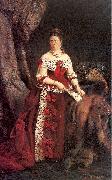 |
Makovsky, Konstantin -- Click Here
|
|
Russian, 1839-1915
He produced historical and social scenes, as well as being a portrait painter of some renown, although his significance lies more in the role he played as a founder-member of the WANDERERS art society in late 19th-century Russia. He studied first at the Moscow School of Painting and Sculpture (1851-8), which had been co-founded by his father Yegor Ivanovich Makovsky (1800-86), under Mikhail Ivanovich Skotti (1814-61) and Sergey Konstantinovich Zaryanko, then from 1858 to 1863 at the Petersburg Academy of Arts. In 1862 he was awarded a Minor Gold Medal, but the following year, together with 13 other students, Makovsky rebelled against the theme set for the Grand Gold Medal competition and left the Academy with the title of Artist of the Second Degree. In 1863 he joined the Petersburg Artel of artists, the forerunner of the Wanderers and the most potent symbol of the break with classical tradition. The reversal of official policy that this engendered led to his being made an academician in 1867, in 1869 a professor and in 1898 a full member of the Academy. As a member of the Wanderers, Makovsky was most notable for his new subject-matter, namely the common people. However, he split with the society in 1883 and by 1891 had become a member of the newly formed and more Salon-orientated St Petersburg Society of Artists, of which he was subsequently to be president. Makovsky often veered towards sentimentalism, giving his works a cloying pathos, as in his portrait of the Stasov Children (early 1870s) and Children Fleeing the Storm (1872), |
|
 |
Makart, Hans -- Click Here
|
|
Austrian Academic Painter, 1840-1884
Austrian painter. He studied (1860-65) at the Akademie in Munich under the history painter Karl Theodor von Piloty whose influence is evident in Makart's Death of Pappenheim (1861; Vienna, Hist. Mus.). Makart visited London and Paris in 1862 and Rome in 1863. The Papal Election (1863-5; Munich, Neue Pin.) reveals Makart's skill in the bold use of colour to convey drama as well as his virtuoso draughtsmanship. Two decorative triptychs, Modern Cupids (1868; Vienna, Zentsparkasse), and the Plague in Florence (1868; Schweinfurt, Samml. Schefer), brought Makart both fame and disapproval (mostly because they lacked a literary original) when exhibited in Munich in 1868. His plan for the second work |
|
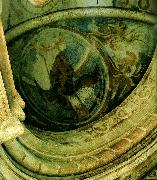 |
majestas domini -- Click Here
|
|
Christ in Majesty, or Christ in Glory, in Latin Majestas Domini, is the Western Christian image of Christ seated on a throne as ruler of the world, always seen frontally in the centre of the composition, and often flanked by other sacred figures, whose membership changes over time and according to the context. The image develops from Early Christian art, which directly borrowed the formulae of depictions of the enthroned Roman Emperor. In the Byzantine world, the image developed slightly differently into the half-length Christ Pantocrator, "Christ, Ruler of All", a usually unaccompanied figure, and the Deesis, where a full-length enthroned Christ is entreated by Mary and St. John the Baptist, and often other figures. In the West, the evolving composition remains very consistent within each period until the Renaissance, and then remains important until the end of the Baroque, in which the image is ordinarily transported to the sky. |
|
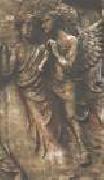 |
MAITANI, Lorenzo -- Click Here
|
|
Italian Gothic Era Sculptor and Architect, ca.1255-1330 |
|
 |
Mair von Landshut -- Click Here
|
|
(active c. 1485 e 1510) was a German engraver and painter.
|
|
 |
Maino, Juan Bautista del -- Click Here
|
|
Spanish Baroque Era Painter, 1578-1649 |
|
 |
MAINO, Fray Juan Bautista -- Click Here
|
|
Spanish Baroque Era Painter, 1578-1649 |
|
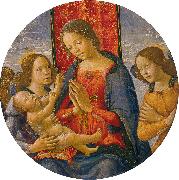 |
Mainardi, Sebastiano -- Click Here
|
|
Italian High Renaissance Painter, 1460-1513 |
|
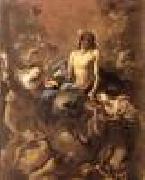 |
MAGNASCO, Alessandro -- Click Here
|
|
Italian Rococo Era Painter, 1667-1749
Painter and draughtsman, son of (1) Stefano Magnasco. He did not study with his father, who died when he was a small child. He went to Milan, probably between 1681 and 1682, and entered the workshop of Filippo Abbiati (1640-1715). His Christ Carrying the Cross (Vitali, priv. col., see Franchini Guelfi, 1987, fig. 238) faithfully repeats the subject and composition of Abbiati's painting of the same subject (Pavia, Pin. Malaspina). Alessandro Magnasco's early works were influenced by the harsh and dramatic art of 17th-century Lombardy, with dramatic contrasts of light and dark and livid, earthy tones, far removed from the bright, glowing colours of contemporary Genoese painting. The depiction of extreme emotion in the St Francis in Ecstasy (Genoa, Gal. Pal. Bianco) was inspired by Francesco Cairo's Dream of Elijah (Milan, S Antonio Abate). However, Magnasco was already expressing himself in a very personal manner, with forms fragmented by swift brushstrokes and darting flashes of light. The Quaker Meeting (1695; ex-Vigan? priv. col., see Franchini Guelfi, 1991, no. 18) is one of his first genre scenes. In this early period he specialized as a figurista, creating small human figures to be inserted in the landscapes and architectural settings of other painters. He also began collaborating with the landscape painter Antonio Francesco Peruzzini, with a specialist in perspective effects, |
|
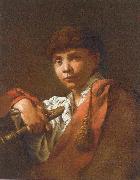 |
Maggiotto, Domenico -- Click Here
|
|
Italian Painter, 1713-1794 |
|
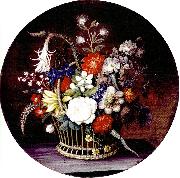 |
magdalene margrethe barens -- Click Here
|
|
Magdalene Margrethe Bärens, född 1737, död 1808, var en dansk konstnär; hon blev den första kvinnliga konstnären i Danmark som valdes in i den danska konstakademin år 1780.
Hon var en av de få kvinnliga konstnärerna kända i Skandinavien före 1800-talet, tillsammans med Ulrika Pasch i Sverige och Helena Arnell i Finland. I Danmark var även Johanne Marie Fosie känd under samma tid. |
|
 |
Maffei, Francesco -- Click Here
|
|
Italian Baroque Era Painter, 1605-1660
Italian painter. He probably trained with his father, Giacomo Maffei, before joining the workshop of the Maganza family in Vicenza. His early works, such as the Ecce homo (ex-Dianin priv. col., Padua, see Pallucchini, 1981,), were influenced by the eclectic style, between Veronese and the Bassani, of Alessandro Maganza. The St Nicholas and the Angel (1626; Vicenza, S Nicola da Tolentino), with colours like those of Veronese, yet lighter, suggests Maffei's rapid development of an independent style that is both rugged and moving. His interest in narrative, already evident in scenes from the Life of St Cajetan (Vicenza, S Stefano), was developed in the later Martyrdom of the Franciscan Minors at Nagasaki (Schio, S Francesco), which is datable to about 1630. Here, the contrast between the pale, silvery tones of the background and the darker foreground figures is derived from Tintoretto, but the exaggerated Mannerist treatment of the main figures also recalls the art of such French engravers as Jacques Bellange and Pierre Brebiette. At the same time there is also an echo of the extreme stylizations of Giovanni Demio. |
|
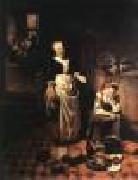 |
MAES, Nicolaes -- Click Here
|
|
Dutch Baroque Era Painter, 1634-1693.
|
|
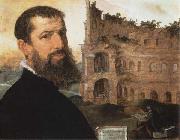 |
Maerten van heemskerck -- Click Here
|
|
Dutch Northern Renaissance Painter, 1498-1574
Dutch painter, draughtsman and print designer. He was among the second generation of Netherlandish artists to travel to Italy, where he was profoundly affected by the work of contemporary artists in Rome and by the examples of Classical sculpture to be seen in the city (see ROMANISM). On his return to the north, van Heemskerck had a long and successful career. His extensive oeuvre (over 100 paintings) comprises large altarpieces, portraits and smaller works (with both religious and mythological subjects). He also produced a vast number of drawings for prints. He helped spread the influence of Michelangelo and Giulio Romano in the northern Netherlands, through his strong, monumental style, with much emphasis on anatomical detail. He was thus an important figure in the dissemination of late Mannerism in northern Europe |
|
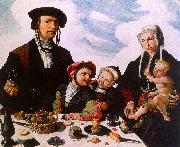 |
Maerten Jacobsz van Heemskerck -- Click Here
|
|
1498-1574
Flemish Maerten Jacobsz van Heemskerck Gallery |
|
 |
Maella, Mariano Salvador -- Click Here
|
|
Spanish Painter, 1739-1819
Spanish painter and draughtsman. He was the son of a Valencian painter of the same name, and in 1751 he went to Madrid, where he studied drawing and modelling under the sculptor Felipe de Castro for two years. However, he felt painting to be his vocation and joined the students directed by Antonio Gonzelez Velezquez at the Real Academia de S Fernando, where he completed his studies in 1757. |
|
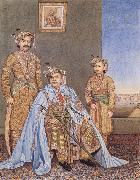 |
Madho Prasad,Ramnagar -- Click Here
|
|
b.1825 r.1835-1889
|
|
|
|
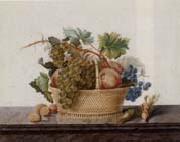 |
Madame Elie -- Click Here
|
|
Active in France during the 19the Century
|
|
|